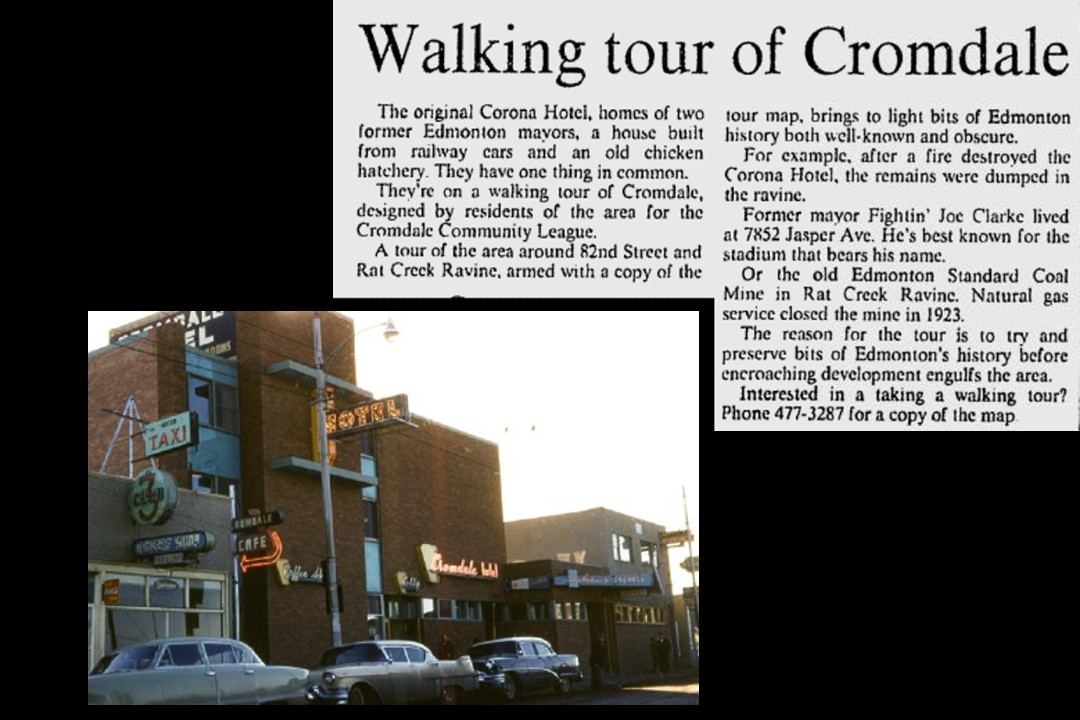On this day in 1979, the Cromdale Community League was offering people tours of historic buildings from the early days of the neighbourhood.
It wasn't just a simple tour but instead happened in the same year that the community league pushed the City of Edmonton to protect 10 historic buildings in the neighbourhood, including the homes of two former mayors.
Cromdale is one of the Edmonton's oldest central neighbourhoods, and it's also one of the most oddly shaped. It extends east to 84 Street NW, with Commonwealth Stadium along its northeastern edge. On the other side, Cromdale bends around Kinnaird Ravine and Rat Creek, creating a neighbourhood that looks a bit like a crooked letter 'C'.
At the turn of the 20th century, the area that became Cromdale was sparsely populated. It was home to the Edmonton Standard Coal Mine, which operated from the mouth of Rat Creek since at least 1907, as well as a few scattered residences. However, the area grew rapidly in the 1910s after Edmonton's streetcar network expanded east. As part of the expansion, the city architect's office designed a new main barn for the streetcars, which was built in Cromdale in 1913. Apparently, it wasn't a smooth process — construction problems seemingly led to the architect's office being shut down.
Once connected with the rest of the city, Cromdale's population swelled, with new brick homes rapidly constructed. That led to the demand for greater services — especially education. Neighbourhood residents began pushing for a new school in 1911. However, at the time, Edmonton's school board was stretched thin trying to supply schools to the rapidly growing city. They repurposed an old wooden schoolhouse as a temporary school in 1917. "Temporary" meant more than a decade, though. It wasn't until 1931 before the more permanent Cromdale School opened. During its construction, the school board emphasized the school would be constructed and furnished with local materials. It was a matter of civic pride that, conveniently, was also cheaper for the cash-light school board. The school served the community until 1980 when it was closed.
Also in the 1930s, Cromdale became the final resting place for another Edmonton landmark. In 1932, fire destroyed downtown's Corona Hotel. For whatever reason, it was decided that the best clean-up plan was to dump the debris into Rat Creek Ravine. The remains of the hotel are supposedly still there, under what's now 111 Avenue.
The early part of the 1900s marked Cromdale's first boom, but it wasn't the last. The 1950s saw the neighbourhood become an entertainment and nightlife hub, which included the now-notorious Cromdale Hotel. More recently, there have been several projects aimed at building higher-density housing in Cromdale and the surrounding area, including the Stadium Yards complex, which is undergoing its second phase of construction right on the western border of Cromdale.
This clipping was found on Vintage Edmonton, a daily look at Edmonton's history from armchair archivist @revRecluse of @VintageEdmonton. Note: The photo collage includes a clipping from 1979 and an undated colour photo of the Cromdale Hotel.

